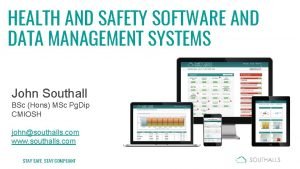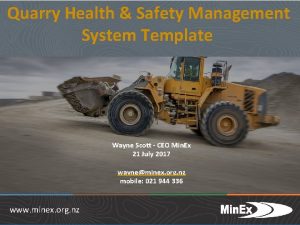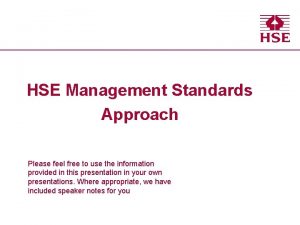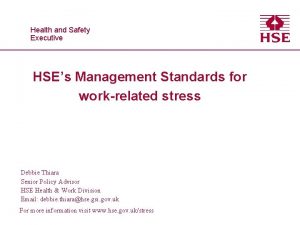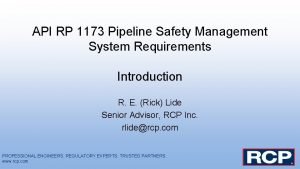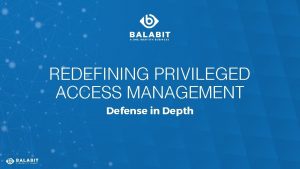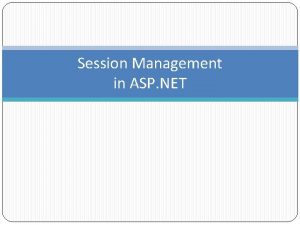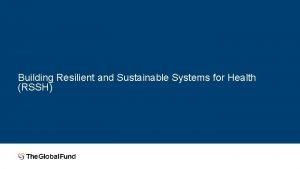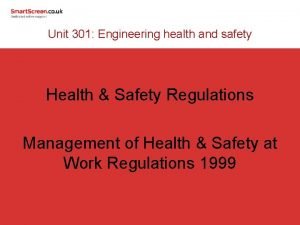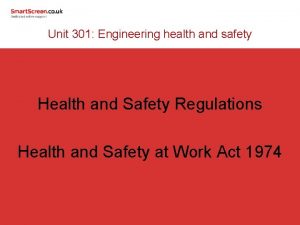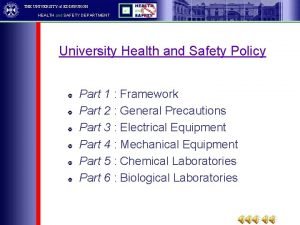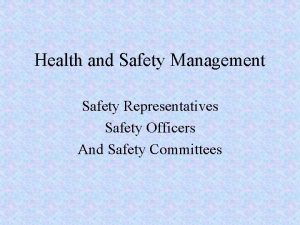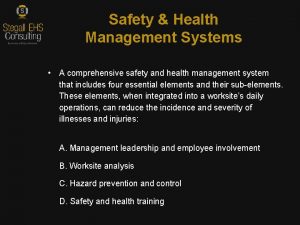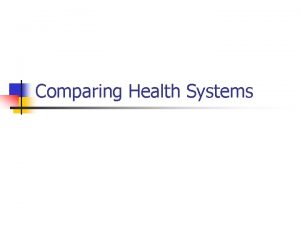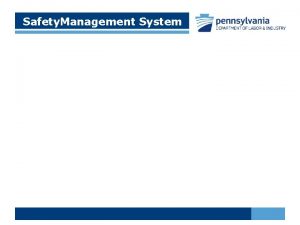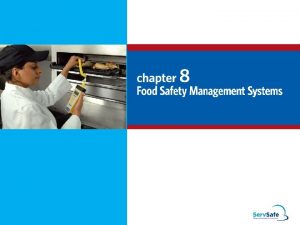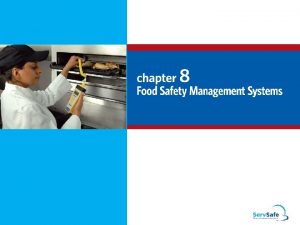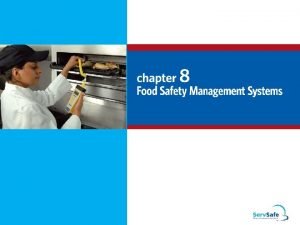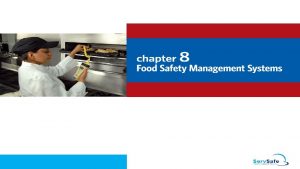Health and Safety Session 4 Safety Management Systems


















- Slides: 18

Health and Safety Session 4 Safety Management Systems and Consultation

Today • • Quick Review Safety Management (Intro) Elements Consultation What You can Do. Quick Modular Overview. Evaluation A. O. B.

Outline Policy Safety Statement Organisation Planning + Implementation Measuring and Reviewing Performance

Policy Elements • Policy needs to be based on Risk Assessment and Consultation and comply with the Law. It should detail: • How the safety management system is designed to work; • The responsibilities of individuals to ensure safety at each level; • The carrying out of on-going risk assessment; • Compliance with statutory requirements; • Maintenance of safety systems; • Provision of safety procedures for processes; • The consultation process; • The auditing procedures; • Training required; • Co-operation by employees, and • Management commitment.

Policy Development Factors • • • Compliance with the law; Insurance contracts; Economic impacts and cost effectiveness; Priorities based on hazard type (Risk assessment); Business priorities; Persons to implement and support the policy; Skills and capability to meet the requirements of the policy; Options to change processes and/or procedures; Future developments; Operational costs, Other contractual arrangements.

OHS Implementation (1) • Keeping up to date on legal requirements for OHS; • Conducting safety audits; • Implementing maintenance programmes for safety of plant and equipment; • Establishing the equipment testing and safety certification programme; • Defining the co-operation required from employees; • Providing appropriate training in general OHS • Informing employees of the safety management strategy; • Establishing the PPE supply and maintenance procedure; • Implementing and maintaining the accident and incident investigation system and reporting procedure;

OHS Implementation (2) • Defining the safety committee role and schedule for meetings etc. ; • Clarifying the role of the Safety Representative and establishing audit procedures etc. ; • Allocation of specific responsibilities to individuals or groups; • Organisation of training courses and training programmes; • Installation of control systems for safety documentation; • Establishment of the procedure for monitoring contractors working on site, • Role and management of external expertise (Consultants etc. )

Safety Monitoring • • • • Safety audits at regular intervals; Specific audits of particular procedures; Use of feedback systems such as safety defects logs; Accident / incident report assessments / analysis; Monitoring of training records: Checks on maintenance logs; Consultation with individuals as representatives of groups or areas of activity at the enterprise; Consultation with the safety committee; Consultation with the safety co-ordinator and others with specific responsibility for health and safety; Assessment of PPE use and the maintenance of the PPE; Audit of adherence to safety procedures (e. g. hot work, confined spaces work etc. ), Audit of safety documentation. ACTING ON ABOVE

Consultation • Employers must consult with employees on promoting and developing health, safety and welfare at work. Employees may also select a Safety Representative. • Safety Reps have specific rights under the Act: – To carry out inspections of the workplace and investigate potential hazards and complaints; – To investigate accidents once they do not interfere with the performance of other statutory functions, (i. e. those of an inspector); – To receive information from the employer which is necessary to ensure the safety and health of employees; – To receive advice and information and make representations to a Health and Safety Inspector; – To have time off ‘as may be reasonable’ for appropriate training and to carry out their role.

1983 Regs. Reg. 12 - Consultation and Participation of Employees • Consultation on OHS matters is required and should be carried out in advance and in good time. This includes consulting employees on any measures contained in the regulations: – Engaging people to carry out protective and preventative services (Reg. 8); – Naming of employees to carry out duties in emergencies (Reg. 9); – The use of external experts to advise on OHS (Reg 8); – The drafting of the safety statement and its revision; – Information arising from the written assessment; – Protective measures (Reg. 10); – Information on accidents and dangerous occurrences; – Planning and organisation of OHS training (Reg. 13); – The effect of the introduction of new technology on OHS.

1. Draw up a Health and Safety Policy • The Health and Safety Policy should be a simple statement of how the company is managing its workplace safety. It should include a commitment to comply with all relevant health and safety legislation and provide a framework for continual improvement by setting targets and objectives. • ‘Hazard‘ means anything that can cause harm e. g. chemicals, electricity, working from ladders etc. • ‘Risk‘ is the chance, great or small, that someone will be harmed by the hazard.

2. Identify the Hazards • Don‘t be overcomplicated. In most firms in the commercial, service and light industrial sector; the hazards are few and simple. Checking them is commonsense, but necessary. If you are a small firm and you are confident you understand the work, you can do the hazards identification and risk assessment yourself. If you are a larger firm, you could ask a responsible employee or safety officer to help you. If you are not confident, get help from a competent source. Consult and involve all employees including the safety representatives as necessary. But remember - you are responsible for seeing it is adequately done. If you are doing the hazard identification and risk assessment yourself, walk around your workplace and look afresh at what could reasonably be expected to cause harm. Ignore the trivial and concentrate only on significant hazards which could result in serious harm or affect several people. Ask your employees or their representatives what they think. They may have noticed things which are not immediately obvious. Manufacturers' instructions or datasheets can also help you spot hazards and put risks in their true perspective. So can accidents and ill-health records.

3. Risk Assessment • 'Risk' is the chance, great or small, that someone will be harmed by the hazard. An assessment of risk is nothing more than a careful examination of what, in your work, could cause harm to people so that you can weigh up whether you have taken enough precautions or should do more to prevent harm. The aim is to make sure that no one gets hurt or becomes ill. Accidents and ill health can ruin lives and affect your business too if output is lost, machinery is damaged, insurance costs increase, or your have to go to court. If you use dangerous chemicals, the assessment of the risks to health and precautions you need to take may have already been set out on the label or safety data sheet. If so, you can consider them 'checked' and write that down when making a written assessment. For other hazards, you probably already know whether you have machinery that could cause harm, or if there is an awkward entrance or stair where someone could be hurt. If so, check that you have taken what reasonable precautions you can to avoid injury.

• Decide who be might harmed and how Apart from employees think about people who may not be in the workplace all the time e. g. cleaners, visitors, contractors, maintenance personnel etc. Include members of the public or people you share your workplace with, if there is a chance they could be hurt by your activities.

4. Decide what precautions are needed • • • You may already have in place some safety measures. Your risk assessment will tell you whether these are adequate or more should be done. You also need to ask yourself if you have done all the things that the law says you have to. Remember; all health and safety laws provide guidance on how to assess the potential risks and the appropriate safeguards. For example, there are legal requirements on prevention of access to dangerous parts of machinery. Then ask yourself whether generally accepted industry standards are in place. But don‘t stop there - think for yourself, because the law also says that you must do what is reasonably practicable to keep your workplace safe. Your real aim is to make all risks small by adding to your precautions if necessary. Improving health and safety need not cost a lot. For instance, placing a mirror on a dangerous blind corner to help prevent vehicle accidents, or putting some non-slip material on slippery steps, are inexpensive precautions considering the risks. If you find that something needs to be done, ask yourself: • "Can I get rid of the hazard altogether? " - if not, • "What safety precautions are necessary to control the risk? "

What does controlling risk mean? • It means and the law requires, you do all that is reasonably practicable to ensure the hazard will not injure anyone. Common sense tells us that life cannot be totally risk free however you are required to do all that is reasonably practicable to minimise the risk of injury. • If you share a workplace, tell the other employers and self-employed people there about any risks your work could cause them and what precautions you are taking. Also, think about the risks to your workforce from those who share your workplace.

5. Record your Findings • The Safety Statement is the place to record the significant findings of your risk assessment. This means writing down the more significant hazards and recording your most important conclusions - for example, • "Electrical installations: insulation and earthing checked and found sound" • You must also inform your employees about your findings. Keep the written document for future reference or use, it can help you if an HSA inspector questions your precautions, or if you become involved in any action for civil liability. It can also remind you to keep an eye on particular matters and it helps to show that you have done what the law requires.

6. Review your programme and update as necessary. • You will need to have some system of checking that your safety measures are working effectively. Monitor them on a regular basis, sooner or later you will bring in new machines, substances and procedures which could lead to new hazards. If there is any significant change, you should add to the assessment to take account of the new hazard. In any case, it is good practice to review your assessment from time to time. • Don‘t amend your safety statement for every trivial change, or for each new job, but if a new job introduces significant new hazards of its own, you will want to consider them in their own right and do whatever you need to keep the risks down.
 Southall safety cloud 2
Southall safety cloud 2 Food safety management system template
Food safety management system template Hsg218
Hsg218 Hsg218
Hsg218 Pipeline safety management system
Pipeline safety management system Active managerial control software
Active managerial control software Balabit pricing
Balabit pricing Asp.net session management
Asp.net session management Health and social care component 3 health and wellbeing
Health and social care component 3 health and wellbeing Decision support systems and intelligent systems
Decision support systems and intelligent systems Rssh health
Rssh health Difference between health education and health information
Difference between health education and health information Chapter 3 health wellness and health disparities
Chapter 3 health wellness and health disparities Health propaganda definition
Health propaganda definition Glencoe health chapter 1 understanding health and wellness
Glencoe health chapter 1 understanding health and wellness Chapter 1 lesson 1 your total health
Chapter 1 lesson 1 your total health Unit 301
Unit 301 Health and safety regulations in engineering
Health and safety regulations in engineering Health and safety advisers edinburgh
Health and safety advisers edinburgh
